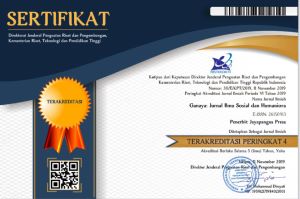Penjor Sebagai Simbol Pencitraan Diri Umat Hindu di Kota Mataram
DOI:
https://doi.org/10.37329/ganaya.v3i1.422Keywords:
Penjor, Symbolic Meaning, Self-ExistenceAbstract
In contemporary development, the penjor is increasingly being used both as a means of religious rituals and as a profane means. This research focuses on 3 questions 1). What is the process of the emergence of penjor in the city of Mataram? 2). What are the types, functions, and meanings of penjor in the city of Mataram? 3). How is penjor a symbol of the self-image of Hindus in the city of Mataram? This study uses a qualitative descriptive approach that emphasizes the interpretation of denotative and connotative meanings by using the theory of symbolic and semiotic interactionism. Data collection techniques by observation, interview, literature study, and documentation. The results of the analysis include: 1) The appearance of penjor in the city of Mataram began with the history of the attack of the Karangasem kingdom to Lombok. The increasingly safe situation of Lombok encourages the transfer of the Karangasem community to Lombok which carries Balinese Hindu traditions, including penjor, 2) Penjor is divided into 2 types namely ceremonial penjor and ornamental penjor. Penjor ceremony is made from bamboo with curved edges, the trunk is decorated with Ambu (young palm leaves) or Busung (young coconut leaves) filled with accessories. Penjor ceremony functioned as a means of religious rituals (god yadnya) and Manusa yadnya. The meaning of penjor symbolizes the mountain and its contents where the gods come from, as a form of expression of gratitude for the gift given by God and the celebration of Galungan. The commodification of penjor in the city of Mataram is still in a standard form but has begun to use a combination of natural and synthetic ingredients. 3) Penjor is a symbol of the self-image of Hindus, showing internal solidarity with other Hindus and externally to present the front stage as a Hindu that refers to the aesthetic and artistic values of religious ritual symbols that contain the values of the Satyam, Siwam, Sundaram.
References
Atmaja, A. T. (2016). Kontestasi Penjor Galungan – Kuningan di Bali Visualisasi Doa Petisi secara Demonstratif untuk Kemakmuran pada Era Masyarakat Tontonan. Jurnal Kajian Bali, 06.
Eliade, M. (2012). The myth of the eternal return: Cosmos and history. In The Myth of the Eternal Return: Cosmos and History.
Hickey, C., & Van Zoest, W. (2012). Reward creates oculomotor salience. Current Biology. https://doi.org/10.1016/j.cub.2012.02.007
Ketut Agung, A. A. (1991). Kupu-Kupu Kuning Terbang di Selat Lombok. Denpasar: Upada Sastra.
Ketut Hery Sony Pratama, S. M. (2006). Komodifikasi Penjor sebagai Sarana Persembahyangan Umat Hindu. Jurnal Studi Kultural.
Koentjaraningrat. (1987). Anthropology in Indonesia. Journal of Southeast Asian Studies. https://doi.org/10.1017/S002246340002052X
Mahaputra, I. W. G., Wirawan, A. A. B., & Eddy, I. W. T. (2016). Komodifikasi Penjor Di Kota Denpasar Tahun 2000 – 2015. Jurnal Humanis. https://doi.org/https://ojs.unud.ac.id/index.php/sastra/article/view/34605
Poloma, M. M. (2013). Sosiologi Kontemporer. Jakarta: Rajagrafindo Persada.
Pradnyanitasari, P. D., Priliandani, N. M. I., Juniariani, N. M. R., & Endra, I. N. (2019). EKSISTENSI PENGERAJIN HIASAN JANUR DENGAN STRATEGI COST REDUCTION. Jurnal Ilmiah Akuntansi. https://doi.org/10.23887/jia.v4i1.16783
Skidelsky, E. (2009). Ernst Cassirer. The Philosophers’ Magazine. https://doi.org/10.5840/tpm20094648
Studi, J., Laporan, K., Komodifikasi, R., Sebagai, P., Persembahyangan, S., Hindu, U., … Bali, G. (2016). Jurnal Studi Kultural. Jurnal Studi Kultural Citra Penjor. Sumber: Magnificient Bali.
Titib, I. M. (2003). Theologi dan Simbol simbol dalam Agama Hindu. Surabaya: Paramita.
Downloads
Published
How to Cite
Issue
Section
License
An author who publishes in the Ganaya : Jurnal Ilmu Sosial dan Humaniora agrees to the following terms:
- Author retains the copyright and grants the journal the right of first publication of the work simultaneously licensed under the Creative Commons Attribution-ShareAlike 4.0 License that allows others to share the work with an acknowledgement of the work's authorship and initial publication in this journal
- Author is able to enter into separate, additional contractual arrangements for the non-exclusive distribution of the journal's published version of the work (e.g., post it to an institutional repository or publish it in a book) with the acknowledgement of its initial publication in this journal.
- Author is permitted and encouraged to post his/her work online (e.g., in institutional repositories or on their website) prior to and during the submission process, as it can lead to productive exchanges, as well as earlier and greater citation of the published work (See The Effect of Open Access).
Read more about the Creative Commons Attribution-ShareAlike 4.0 Licence here: https://creativecommons.org/licenses/by-sa/4.0/.








